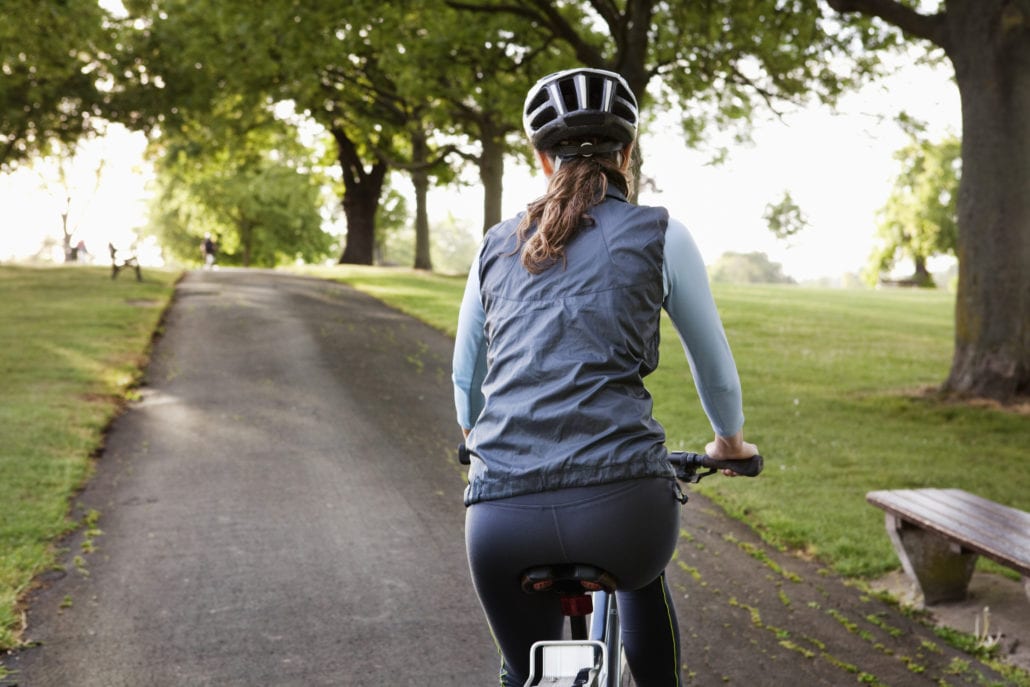Don’t let an ostomy stop you from having some summer fun
By Annemarie Finn
When I received my bladder cancer diagnosis and the treatment plan, a radical cystectomy with an ileal conduit, I was devastated. Like so many, I went through many stages: Denial, Anger, Bargaining, Sadness and Depression, and finally, Acceptance. It felt like a double whammy. It seemed like the “cure” was worse than the disease. I would be forever changed. It was hard to wrap my brain around. It is one of the reasons I decided to write about my experience. I had no idea what to expect and did not know where to turn. I saw some videos of survivors with ileal conduits but, I did not relate with the speakers. They were 20-30 years older than I was. I really did not want to envision a life as an elderly person before it was time.
I can use a public restroom without having to sit on the gross toilet!
What would my quality of life be? I was terrified that life, as I knew it was over. Would I be able to work? What activities would I be able to do? What would I never do again? I had so many questions and fears.
 So, what can I do now that I have a urostomy?
So, what can I do now that I have a urostomy?
Honestly, I can do everything I could do before. When you first get out of surgery, you are hardly able to walk around your room. When you go home, the end of the driveway is a monumental trek. By persevering and trying to walk more everyday, I was able to go from measuring distance in feet to measuring in miles. Today, I try to walk 5-10 miles a day! I have hiked intermediate trails in the hills of Eastern Massachusetts. I have discovered miles of trails in my hometown that I didn’t even know existed. I am probably healthier than I was before I got sick.
Can you take a bath?
People often ask if you are able to bathe with a bag. It is very nerve wracking initially to expose your stoma. They are fairly active. I call my stoma, Squirt, when he (yes, it’s a he) acts up. He does spray urine. Picture a male toddler squirting. That’s what it’s like. We have no control over it. That’s why we wear a pouch.
As you can see, a urostomy after a radical cystectomy is a life changer, but in a good way.
You can wear your urostomy bag in the shower. You do not need to cover it or keep it dry. It is a good idea to dry the skin around it with a hair dryer on low when you are done. You can even take your bag off and shower without it. I am over two years out from my surgery and that is how I prefer to do things on my change day. I change my bag every 3 days. I prepare all of my materials (bag, ring, barrier, paper towels, remover spray) then remove my bag. I then take a shower. I wash the skin around the stoma with just water or soap for sensitive skin. Just make sure you do not leave behind any lotion or any residue that would affect the barrier sticking to your skin. I keep paper towels ready to catch any drips when I am done and dry the skin with a hair dryer on the cool setting. I then just put on my prepared bag. I have some skin issues and find this helps with the itching and discomfort. It feels so good not to have the bag on for a while.
What about swimming?
I am a water rat. I can be in the water for hours, literally hours. It doesn’t matter if it is in the ocean, a lake, or a pool. I have done them all. Personally, it has not affected the amount of time I am able to wear a pouch. I am still able to go 3 days. I am able to swim, kayak, and paddleboard with my urostomy. I even just float. It has not interfered with my love of water at all. Even better, I can wear a regular bathing suit. I have worn tankinis for years, and not because of my urostomy. I no longer have a toned teenage body. I don’t even have a toned 30 something body. I like 2 piece tankinis as they hide a multitude of sins. After I got my urostomy, I decided to buy regular 2 piece bathing suits. Ironically, I am much more comfortable with my new imperfect body than I ever was before. My family laughs at me because, where I was self-conscious before, I now show off my body. Maybe it was having so many strangers looking at my most intimate body parts in the hospital or maybe I am proud of my battle scars. You cannot see my bag with my bathing suit on. It’s honestly no big deal.
 There are so many other things I have been able to do since my urostomy. I ride my bike. I participated virtually in the Norton Cancer Institute Bike to Beat Cancer, a 35 mile bike ride. I did it in steps but I gave myself a pass since it was only months after my surgery. I garden, do yard work, spread mulch, work, travel, you name it. As you can see, it has not limited me in any way. Because of my urostomy and thanks to my night bag, I can sleep through the night without having to get up to use the bathroom. That means I can drink up until I go to bed! I can sit through long car rides and movies with said night bag. I can use a public restroom without having to sit on the gross toilet! I can write my name in the snow!!! That is not conjecture, I actually did it. My sex life is good. I am planning a European vacation. Both of those will be the topics of future blogs.
There are so many other things I have been able to do since my urostomy. I ride my bike. I participated virtually in the Norton Cancer Institute Bike to Beat Cancer, a 35 mile bike ride. I did it in steps but I gave myself a pass since it was only months after my surgery. I garden, do yard work, spread mulch, work, travel, you name it. As you can see, it has not limited me in any way. Because of my urostomy and thanks to my night bag, I can sleep through the night without having to get up to use the bathroom. That means I can drink up until I go to bed! I can sit through long car rides and movies with said night bag. I can use a public restroom without having to sit on the gross toilet! I can write my name in the snow!!! That is not conjecture, I actually did it. My sex life is good. I am planning a European vacation. Both of those will be the topics of future blogs.
What about what I can’t do
The list of what I can do is long. What about what I can’t do. I can’t pee like I used to. I am careful about lifting. I had a hysterectomy with my radical cystectomy so no more children for me. Since I was in my late 50s when I had my surgery, it’s not really an issue but, I am trying to be honest here. That is something to consider if you are younger. Definitely talk to your doctor if you want children. I can’t play the piano, but I couldn’t before. That’s about it.
As you can see, a urostomy after a radical cystectomy is a life changer, but in a good way. You can still do what you did before and even try new things. Even better, it is a life saver. Go out and live your best life. That’s what I am doing.








